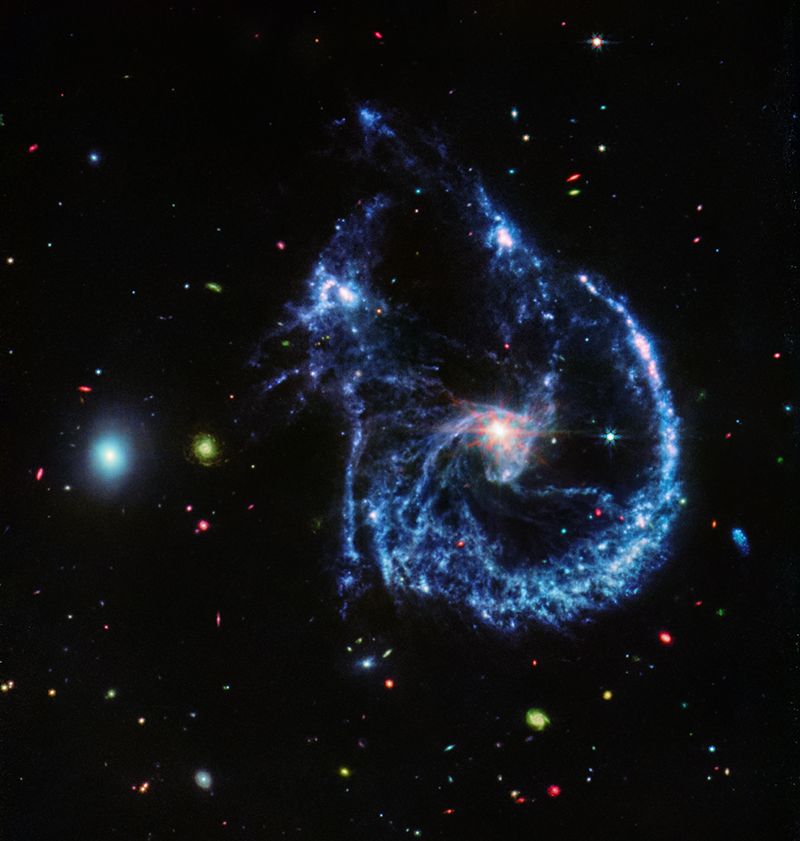In this pair of interacting galaxies, only the one-armed spiral glows brightly in mid-infrared light. Young, forming stars surrounded by dusty silicates and soot-like molecules glow in blue.
Credit: NASA, ESA, CSA, STSc
Source

In this pair of interacting galaxies, only the one-armed spiral glows brightly in mid-infrared light. Young, forming stars surrounded by dusty silicates and soot-like molecules glow in blue.
Credit: NASA, ESA, CSA, STSc
Source
https://www.europesays.com/us/373232/
Single-pulse single-particle time-resolved X-ray diffraction imaging Single-pulse single-particle …#us #news #usnews

https://www.europesays.com/us/373232/
Single-pulse single-particle time-resolved X-ray diffraction imaging Single-pulse single-particle …#us #news #usnews
Direct observation of rotation of polarization at 90-degree domain walls in BaTiO3
2023 Jpn. J. Appl. Phys. 62 SM1003
iopscience.iop.org/article/10.3...
#JJAP
#physics
#Openaccess
#convergent
#beam
#electron
#diffraction
#STEM
#CBED
#polarization

Direct observation of rotation of polarization at 90-degree domain walls in BaTiO3
2023 Jpn. J. Appl. Phys. 62 SM1003
iopscience.iop.org/article/10.3...
#JJAP
#physics
#Openaccess
#convergent
#beam
#electron
#diffraction
#STEM
#CBED
#polarization
This pair is connected by a bridge of material from a past interaction. The upper galaxy also has a clumpy tail perpendicular to its disk.
Credit: Fig. 12 from Smith et al. 2010.
Source

This pair is connected by a bridge of material from a past interaction. The upper galaxy also has a clumpy tail perpendicular to its disk.
Credit: Fig. 12 from Smith et al. 2010.
Source
In my store, I am offering canvas prints, pillows, coffee mugs, and fluffy blankets:
store.elkement.art
Pillows and mugs show two different artworks on each side!
Thanks!




In my store, I am offering canvas prints, pillows, coffee mugs, and fluffy blankets:
store.elkement.art
Pillows and mugs show two different artworks on each side!
Thanks!
Also yes diffraction is one of my favorites too! It's surprisingly simple to implement but looks super impressive
Also yes diffraction is one of my favorites too! It's surprisingly simple to implement but looks super impressive
Glass diffraction always blows my mind on these things, haha.
Glass diffraction always blows my mind on these things, haha.


Webb's observations suggest that early galaxies' brightness is due to hot matter around black holes, not just star formation.
flic.kr/p/2qcjUQk

Webb's observations suggest that early galaxies' brightness is due to hot matter around black holes, not just star formation.
flic.kr/p/2qcjUQk
🤝 Organised in close collaboration with @ccit.ub.edu, @icn2.bsky.social and @uab.cat
icmab.es/icmab-resear...

🤝 Organised in close collaboration with @ccit.ub.edu, @icn2.bsky.social and @uab.cat
icmab.es/icmab-resear...
Your TEM can now solve crystal structures on its own.
Small molecules, materials, proteins—all with one platform: REyes, the first end-to-end autonomous electron diffraction suite
doi.org/10.1021/jacs...
@caltechcce.bsky.social @uclacb.bsky.social

Your TEM can now solve crystal structures on its own.
Small molecules, materials, proteins—all with one platform: REyes, the first end-to-end autonomous electron diffraction suite
doi.org/10.1021/jacs...
@caltechcce.bsky.social @uclacb.bsky.social





Probing the geometry dependence of the Casimir-Polder interaction by matter-wave diffraction at a nanograting
M. Bruneau, J. Lecoffre, G. Routier, N. Gaaloul, G. Dutier, Q. Bouton and T. Emig
#FreeToRead #FocusArticle
👉 iopscience.iop.org/article/10.1...


Probing the geometry dependence of the Casimir-Polder interaction by matter-wave diffraction at a nanograting
M. Bruneau, J. Lecoffre, G. Routier, N. Gaaloul, G. Dutier, Q. Bouton and T. Emig
#FreeToRead #FocusArticle
👉 iopscience.iop.org/article/10.1...
What it revealed was this: fuzzy edges with four distinct "spots" in an X pattern in the interior.
This was compared to the chemical structures worked out for the nucleotides themselves, suggesting a stacked pattern of interacting bases.

What it revealed was this: fuzzy edges with four distinct "spots" in an X pattern in the interior.
This was compared to the chemical structures worked out for the nucleotides themselves, suggesting a stacked pattern of interacting bases.
The paperclip with its precious cargo was exposed to X-rays for 61 hours to accumulate...
The paperclip with its precious cargo was exposed to X-rays for 61 hours to accumulate...

